*This story is part of a special project on Innovators in Latin American and Caribbean Journalism.
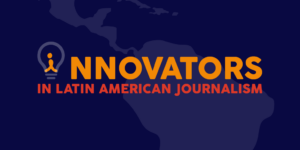 Uruguayan newspaper la diaria, born in 2006, is an atypical case in the Latin American media environment. Its experience offers a sum of innovative elements in areas such as journalistic formula, business model and the media-audience relationship, among others.
Uruguayan newspaper la diaria, born in 2006, is an atypical case in the Latin American media environment. Its experience offers a sum of innovative elements in areas such as journalistic formula, business model and the media-audience relationship, among others.
With initiatives, such as its management by a worker’s cooperative, the launch of paid vertical channels,, its bet on digital subscriptions or its innovation laboratory known as la diaria LAB, this newspaper from Uruguay has managed to gain a foothold in the innovative Latin American media landscape.
Additionally, la diaria was recently one of the five international media organizations selected by The Membership Puzzle initiative, founded by the Studio 20 program at New York University and the Dutch media De Correspondent, to study and analyze, in-depth, journalistic models supported in a special way by users through subscriptions or memberships.
Birth of la diaria
La diaria, which is based in the Uruguayan capital of Montevideo, started publishing in print from Monday to Friday in 2006. The idea of creating this new newspaper emerged from a group of university students, including Damián Osta, current general manager of the newspaper.
"
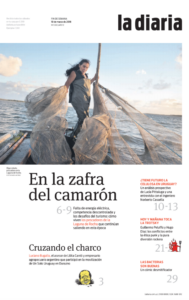
Cover of the March 10 weekend edition of la diaria (Courtesy)
We had nothing to read," Osta explained to the Knight Center. “We were a group of citizens and critical readers who did not agree with the press offerings in Uruguay at the time." So they decided to try to create their own newspaper.
The preliminary debates and preparation began in 2004, a couple of years before the newspaper officially launched. "There were many conversations in which we met with people who felt the same as us," Osta said. The first big challenge was to "bring together a team of journalists who matched with the newspaper we wanted,” with the additional difficulty of "having zero business management experience and no capital."
Thus, the team began to raise funds among future readers to finance the newspaper. But as Osta explains, at that time there was not a favorable culture in Uruguay for financing startups, so the initial amount collected was only $40,000. Among others, journalist and writer Mario Benedetti, who died in 2009, contributed funds. With that initial capital, a company was created that is managed by a workers' cooperative (today, Cooperativa la diaria is composed of 40 percent of the workers of the company).
The next step was trying to get subscriptions. They managed to reach 1,200 people who decided to pay in exchange for a newspaper that did not yet exist, but who were convinced by la diaria’s pitch.
First innovation: creating a logistics company
The first major innovation in la diaria’s business model was the bet on creating its own distribution system. "We were certain," Osta said, "that we had to create a distribution channel of our own, because there was a lot of dependence and [there were] very damaging rules that the monopoly of distribution of newspapers and magazines wanted to impose on us.” "And that was in a certain way the original success: although it increased the challenge of creating a logistics company, as well as a journalistic one, it allowed us to build a direct link with the people,” the general manager added.
Today, of the 137 employees at la diaria, 56 work in distribution, handing out the print paper everyday to the homes of subscribers throughout the national territory.
Second innovation: format
The next relevant innovation has to do with la diaria’s journalistic model. Osta explained that "from the beginning we proposed that the subscriber needed a summary. The claim was 'only what matters.'" Thus, the proposal was to launch a newspaper of just 16 pages in tabloid format, distributed from Monday to Friday, and in black and white, but "with close proximity to the reader using visual and written storytelling.”
From the beginning, la diaria bet on constructing “journalistic coverage of its own, which often generated some surprise; we were a rare case,” Osta said. But for the general manager, “that rarity, all the weirdness that we built during those years, is today our main strength. The newspaper that depends only on you. That only offers you what matters.” The subscriptions also helped to reinforce the idea of community, which is essential for la diaria’s gamble.
Subscribers of la diaria “are possible because society was changing that way, if not we would be much more niche,” said Lucas Silva, 37-year-old editor-in-chief of la diaria. He has been part of the project since its inception, first covering political and economic information and, since 2014, working as editor-in-chief.
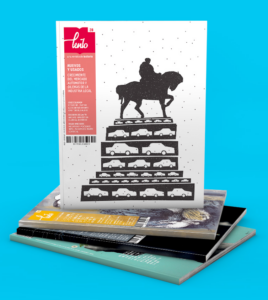
Lento is a monthly narrative journalism magazine lauched by la diaria five years ago. Its director, Gabriel Lagos, said it was born “as an alternative to what the newspaper did, as a product that could be prepared with more time and a more tranquil reading.” (Courtesy)
For years, la diaria was published only from Monday to Friday. But last year those in charge decided to also bet on an edition for the weekend, which was launched in April 2017. "Also against the grain of any company manual," Osta explained, “we went out into the street with a print edition where the value object is very big and the attention we pay to graphics is, too.” This weekend edition, which is distributed to subscribers on Saturday, has 32 pages and is printed in full color.
The initiative has been a success. The weekend edition, which has the most subscribers, costs about $9 per month. And thanks to it, la diaria has managed to increase the sales for subscriptions 39 percent. The subscription from Monday to Friday costs $23 dollars per month (the digital, which is discussed below, has a cost of $12 per month).
According to data provided to the Knight Center by Damián Osta, la diaria currently has 12,503 subscribers, distributed as follows:
Today, la diaria is Uruguay’s second newspaper and even aims to challenge El País’ leadership in the space, something that was difficult to imagine when the project was launched in 2006.
“When we started, we did not think that we would be able to be the second newspaper, and compete with El País for leadership. I think we interpret political changes well,” Silva said.
According to data from the Circulation Verification Institute (IVC, for its initials in Spanish) that was provided to the Knight Center by Osta, for the month of October 2017, the leading newspaper in Uruguay, El País, had a circulation of 16,298 copies from Monday to Friday (6,275 in kiosks and 10,023 subscribers). The second newspaper was la diaria, with a weekly circulation of 6,807 copies (4,969 print subscribers and 1,838 digital subscribers). And the third was El Observador, with 3,192 copies (913 in kosks, 1,611 print subscribers and 668 digital subscribers).
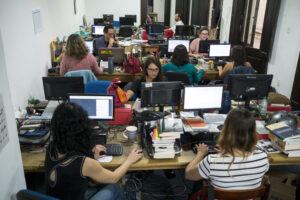
Part of la diaria's newsroom (Courtesy)
For the weekend, El País is first with a circulation of 20,315 copies, la diaria is the second newspaper with 8,189 copies (all subscribers), and El Observador is third with a circulation of 5,288 copies.
April 2 will be an important day for la diaria, since the redesign of the print edition that will be published from Monday to Friday will be launched. La diaria will become "a newspaper/magazine with 24 full-color pages," according to Osta. "We are going to enlarge the newspaper, but we are also going to reduce it in its format, so that it looks more like a daily magazine than a newspaper," he added. (The new print size will be 10.2 x 12.5 inches).
Third innovation: digital subscription
In January 2015, la diaria launched its digital subscription with the aim of "transferring the building of community, that we had done around paper, to digital,” Osta said.
After just over 3 years, 16 percent of la diaria’s subscribers are digital, and the goal is to double that percentage in the coming years. In absolute figures, there are about 1,400 digital subscribers who pay about $12 a month.
To this point, the subscription model has been the following: users could read two news articles per day for free, and they had to subscribe to be able to consume the rest. However, la diaria is modifying the system to offer 10 free articles per month without registration. Once registered, readers can read 20 more per month for free. To consult more news, users must subscribe.
As Silva explained, the content that appears on the newspaper’s website was first in the print edition of la diaria. Additionally, four or five online-exclusive articles are uploaded online by a small team each day.
Fourth innovation: a bet on verticals
La diaria’s bet on strictly digital information is expanding in the form of specialized vertical channels rather than through the enrichment of general information.
In May 2017, the newspaper launched its first digital vertical, dedicated to the world of education. La diaria Educación is an information service specifically for the educational community in Uruguay. It covers information at the three levels of the Uruguayan school system: primary, middle and tertiary.
La diaria Educación is a monthly subscription service that also gives access to all la diaria’s digital content. It has a specific team of three journalists who specialize in the area of education.
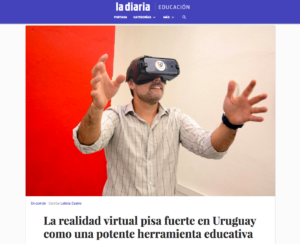 Osta explained that, to prepare the launch of this product, "what we did was create an advisory board, formed by subscribers who were experts in education, and assign three journalists to be exclusively dedicated to education. That allowed us to greatly improve the newspaper’s journalistic coverage of the subject." One of the services of la diaria Educación is a specialized newsletter already received by 1,200 professionals in the educational world.
Osta explained that, to prepare the launch of this product, "what we did was create an advisory board, formed by subscribers who were experts in education, and assign three journalists to be exclusively dedicated to education. That allowed us to greatly improve the newspaper’s journalistic coverage of the subject." One of the services of la diaria Educación is a specialized newsletter already received by 1,200 professionals in the educational world.
The solid performance of la diaria Educación –it has reached some 700 specific subscribers– has encouraged the team to prepare the launch of new verticals, which they refer to internally as "emerging.” So, on April 2, a new series of verticals dedicated to the following themes will be born: Health, Work, Feminisms, Science, Sport (the latter will be called “Garra” or claw). Each will have its own identity and its own presence on social networks, although they will form part of la diaria’s global offerings.
To launch these verticals, la diaria is expanding its newsroom, which is currently composed of 37 professionals. The aim is to have specialized journalists in each subject. They expect at least seven journalists to join the team.
The specific case of the new sports vertical, "Garra," is special: it is being created "in alliance with the soccer players" of Uruguay, according to Osta. Some time ago, "the Uruguayan soccer players organized themselves and created a movement called 'More united than ever' to defend their rights, and the meetings of that union were held at la diaria, on the ground floor of our newsroom," the newspaper’s general manager explained.
The result of this close link is the new vertical, for which they are looking for 500 founding partners "who can participate in editorial meetings in some way," Osta said.
Those responsible for la diaria believe that, in the future, the print edition "has to be transformed into a sort of catalog of these emerging ones," Osta said. "We have a lot of specialized information that has a lot to do with the concerns, desires and obsessions of our subscribers, and in the paper edition a part of that information pyramid that emerges from a community of knowledge will be published," he added.
Fifth innovation: la diaria LAB
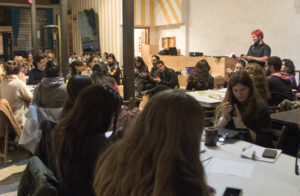
A Virtual Reality workshop hosted at la diaria LAB, in which subscribers and colleagues from other media participated. (Courtesy)
La diaria’s newsroom is located in the old city, in the heart of Montevideo. The ground floor of the newsroom was once a community space called Café la diaria, which has now been transformed into la diaria LAB. It’s an innovation laboratory, open to the public, which wants to enable investigation, production and implementation of new journalistic formats.
Meetings of all kinds are held here with subscribers and other people linked to la diaria. They also prepare formal programs, such as a workshop on virtual reality and immersive journalism that was held in May last year and attended by subscribers and even journalists from la diaria’s competitors.
Sixth innovation: community of knowledge and creation
Those responsible for la diaria like to define their project as "a community of people who share information, concerns, tastes and knowledge,” and who "accept to pay a membership to be part of and make possible a space of shared sensibility," as explained in a project presentation document.
Osta believes that the raison d'être of la diaria is "to manage a community of knowledge." Seventy percent of la diaria’s subscribers have university training. "Knowledge," Osta said, "can no longer flow unidirectionally. We have to find ways to give feedback to what we do and improve the journalism we make with the knowledge our subscribers have."
A good example of the function that la diaria wants to exercise as a catalyst for a community of knowledge is the Río Abierto project, which was one of 11 projects selected and financed by ALTEC (Latin American Alliance for Civic Technology). This entity is the result of an alliance between Omidyar Network, Avina Americas and Fundación Avina and seeks to promote the development of civic technology initiatives in Latin America.
The Rio Abierto project aims to "democratize access to information on the quality and management of water in the basin of the Santa Lucía river and the Río de la Plata," as explained on the website. To do this, it uses information visualization tools and promotes awareness and citizen participation actions for the care of key resources such as water.
The origin of this project came from the controversial installation of a new pulp plant in Uruguay by Finnish company UPM. La diaria wanted to speak with subscribers, scientists, environmentalists and governing authorities about what their informative role should be in relation to this topic. An alliance with experts from the world of higher education underscored that the situation of the rivers "was extremely critical throughout the national territory," Osta explained. That is why they decided to pursue the Río Abierto project, with the aim of offering clear information on the matter.
Subscribers played an especially active role: 900 responded to la diaria’s survey on the use and care of water and their information needs in this area.
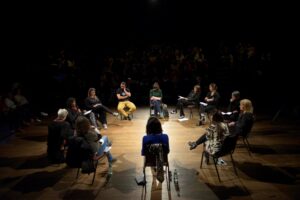
A discussion on Feminisms and the Future as part of la diaria’s 2017 Day of the Future events. (Facebook)
The central core of this project is integrated by la diaria’s project manager, Lucía Pardo, who acts as coordinator, Natalia Uval, who is in charge of the journalistic part, and lawyer Ana Tuduri, environmental activist.
Another project driven by la diaria that shows its capacity to become a catalyst for a community of knowledge is Día del Futuro (Day of the Future), which was created seven years ago. La diaria brings together subscribers and representatives from academia, civil society and political parties to discuss the future of the country. Each year a specific topic is defined and more than a hundred activities such as workshops, conferences or hackathons are held during the month of September.
As Lucía Pardo, la diaria’s project manager, pointed out, the newspaper "poses to subscribers that they will be working on a specific topic in order to know who wants to participate and in what way, and to know which topics they have specific knowledge in.”
Pardo, who studied Food Engineering and joined the team in 2011 for the first edition of the Day of the Future, considers that "the in-depth contact with subscribers, who bring knowledge in multiple ways and their commitment" is a great example of innovation. And this direct relationship with the subscribers is "a great strength" for la diaria, which other newspapers perhaps do not enjoy.
The event has been gaining prominence and two years ago the Uruguayan Parliament unanimously approved the creation of a Day of the Future for the country, which was proposed by la diaria, as Pardo explained.
The next campaign
"Let's do the impossible" is the name of the new campaign that la diaria is about to launch. With it, the newspaper wants to go a step further in its innovative strategy, since it has proposed that 100 percent of its budget will be paid by the subscribers (currently the percentage that subscribers contribute is 79 percent of the total).
The novelty that la diaria intends to apply is the following: if it manages to reach that 100 percent, it commits to allocating all the money gained through advertising –which currently accounts for 15 percent of the budget– to finance new journalistic projects that will be chosen by members of the la diaria community.
According to the general manager of the newspaper, if they achieve this goal, "we will be increasing the amount and diversity of content that our customers receive, which in turn will make the digital subscription for la diaria more attractive.” In absolute figures, la diaria calculates that some US $30,000 per month could be allocated to financing new journalistic projects.
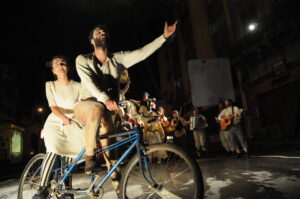
A photo of a celebration of la diaria's anniversary that started with street art in front of the newsroom and ended with a party for subscribers. (Courtesy/PABLO NOGUEIRA)
Scarcity and innovation
At la diaria, innovation has often been linked to the lack of resources. Its general manager, Damián Osta, sums it up like this: "I always say that innovation is often the daughter of scarcity, and scarcity is our identity brand.”
But la diaria’s numbers are improving. Last year it had a total turnover of US $2,480,000. As Osta explained, "today we are a newspaper that does not have losses." And the goal in the coming years is to grow.
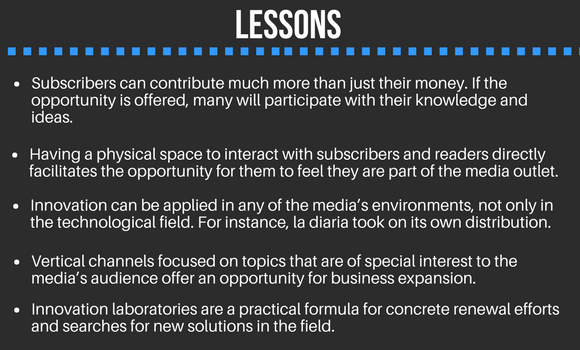
The "Innovators in Journalism" series, made possible thanks to generous support from Open Society Foundations, covers digital news media trends and best practices in Latin America and the Caribbean. It expands upon our previous series and ebook, Innovative Journalism in Latin America, by looking at the people and teams leading innovative reporting, storytelling, distribution and financing initiatives in the region.